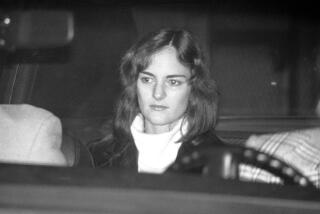Did Celebrity Kill Amelia Earhart? : PBS DOCUMENTARY SUGGESTS THE AVIATOR MAY HAVE BEEN LOST BEFORE HER LAST FLIGHT
- Share via
A new documentary on famed aviator Amelia Earhart, premiering Wednesday on PBS’ “The American Experience,” doesn’t attempt to solve the mystery of her disappearance 56 years ago while on the last leg of her flight to circumvent the Equator.
“The mystery is more in her life than in her disappearance,” says co-producer Jane Feinberg. “I was very interested in her motivations--what made her do what she did.” The more she learned about Earheart, the more Feinberg came to view the story of the aviator’s life as “a tragedy.”
“I’m really left with sadness about her story more than anything else.”
“I think she kind of lost her way in the job of being a hero,” says producer-writer-director Nancy Porter. “It’s hard work being a hero.”
Narrated by Oscar-winner Kathy Bates, “Amelia Earhart” features newsreel footage, including never-before-seen outtakes, excerpts from Earhart’s poetry and interviews with Gore Vidal;, Sally Putnam Chapman, granddaughter of Earhart’s publisher-promoter husband, George Putnam;, fellow flyers Bobbi Trout and Elinor Smith; navigator Bradford Washburn, who almost went on the final fatal flight, and Earhart’s first cousin Nancy Morse.
Earhart, Feinberg says, accomplished much during her 39 years and “did so much in being a symbol, especially for women. But, ultimately, what was left for her as a person I think was not very much. Before she disappeared from the headlines and the spotlight, in a sense she was losing herself. I think she got caught up in the celebrity treadmill.”
According to Porter, the documentary’s point of view kept changing up to the last minute. “I think what I really wanted to show were her frailties as well as her strengths,” Porter explains. “I think she has often been pictured as a very passive person who was pushed into her death or pushed into her celebrity and was very modest and didn’t want it. I thought she was really ambitious.”
Born on July 24, 1897, Earhart took her first airplane ride at the age of 23. In 1928, she met publisher and promoter George Palmer (G.P.) Putnam, who had published Charles Lindbergh’s best-selling account of his 1927 Atlantic flight. Looking to create a “Lady Lindy,” Putnam arranged for Earhart to make a transatlantic flight, not as a pilot but as a passenger. Still, when the “Friendship Flight” landed in England, Earhart became an immediate celebrity. Putnam and Earhart also made sure she stayed in the limelight through lectures, interviews and such endorsements as Amelia Earhart luggage.
“She was very much a product of her time,” Porter says. “She was a media celebrity and was trapped in the need to keep it all going, to keep her life going.”
In 1931, Earhart married the recently divorced Putnam, who also was her manager. Whether they loved each other or married out of convenience is still a matter of speculation. The following year, Earhart flew solo across the Atlantic and her celebrity soared even higher.
In 1936, Earhart planned what she hoped would be her last flight--to circle the Equator. But Earhart and her navigator, Fred Noonan, disappeared on July 2, 1937, on their way from New Guinea to a scheduled stopover on the tiny Pacific atoll of Howland Island.
“I think this is a woman who in childhood never got the genuine article--the genuine love and affection and appreciation that a child needs,” Feinberg says. “The adulation of hordes of people, of a whole country, didn’t make up for it. I think Amelia liked being in the limelight for a time. But I think she got really tired of it. She was a product. It was Amelia Earhart, Inc.”
“I think she bought into this amazing lifestyle with Putnam,” Porter says. “I think the two of them were a business team and without him, I don’t know if she would have been able to maintain the celebrity. I think he did all the planning.”
Earhart seemed to be all things to all people. It seems apparent that those interviewed still have conflicting feelings and opinions about the aviator. ‘She’s a kind of tabula rasa personality,” Porter offers. “She’s lovely and modest and charming, so you can project a lot of different qualities on her. I think that’s one of the things that made her such an icon.”
When Feinberg began research last year, she opened a post-office box and placed ads in different magazines requesting information from those who knew Earhart. “One of the things we encountered during our research was this ‘St. Amelia’ society,” Porter says. “People just wanted to think of her only as perfection. It was harder to find, not so much detractors, but people who could talk about her in more human terms.”
Feinberg’s research also took her to Purdue University, which houses the largest collection of what she describes as “Ameliabilia.” “They have a really wonderful collection of photographs and documents,” Feinberg says. “We got things through the post-office box and a number of anonymous donors, which had never been part of the public record.”
Among the donations are Earhart’s lyrical poetry, which is read throughout the documentary. “We got that from a number of different sources,” Feinberg says. “It had been presumed missing or lost.”
“The American Experience: Amelia Earhart” airs Wednesday at 8 p.m. on KVCR and 9 p.m. on KPBS and KCET.
An Unfinished Poem
Merciless life lasts in the burning sun,
and only death slows circling down
-AMELIA EARHART
More to Read
The complete guide to home viewing
Get Screen Gab for everything about the TV shows and streaming movies everyone’s talking about.
You may occasionally receive promotional content from the Los Angeles Times.







